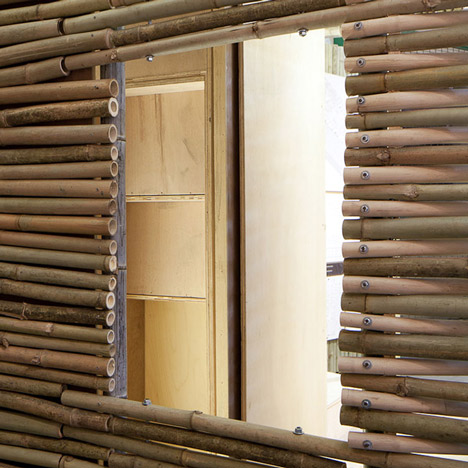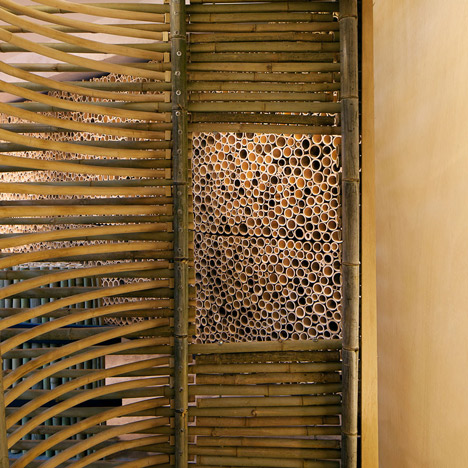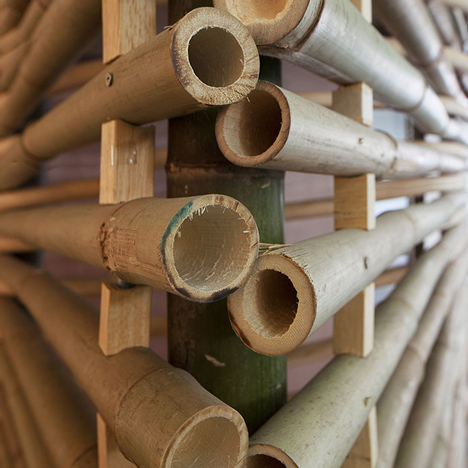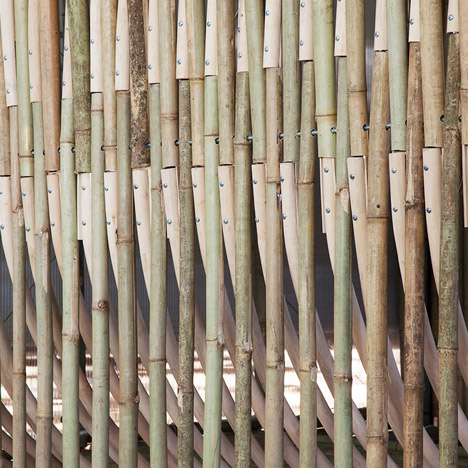as a cheap and sustainable building material, according to Dylan
Baker-Rice, principal at Hong Kong studio Affect-T (+ interview).
"Bamboo is becoming increasingly popular as a building material in
architecture, interior, and industrial design," said Baker-Rice in an
interview conducted as part of our series about bamboo architecture.
"We are using bamboo more and more in much of own work as we notice
many other designers are in Asia and South and Central America. We
expect to see a lot more of it in upcoming buildings, in particular here
in China."
Earlier this year Affect-T unveiled proposals for cheap, lightweight bamboo micro-homes, which could be constructed inside disused factories to help solve Hong Kong's housing problem.

The prototype three-metre-wide structure was made of canes held together with a custom-designed system of bolts and fasteners.
Bamboo is an ideal material for such projects, Baker-Rice said, due to its low cost and availability.
"Because of its abundance in Asia it is very cheap, plentiful, easy
to harvest, and easy to transport requiring very little infrastructure
to successfully grow and cultivate," he said, adding that it is highly
sustainable, since it can simply be composted after use.
Bamboo can perform most of the things that timber is used for in
building but in a novel manner, being tubular and moderately flexible,"
said Baker-Rice, adding that it had several advantages over other
building materials.
"Its strength to weight ratio exceeds that of brick and timber while
its tensile strength exceeds that of common steel," he said. "Bamboo is
relatively slow burning when compared to timber. This is why it is
preferred to metal scaffolding for nearly every building in China for
minor works to full construction."

He added: "Once the scaffolding is finished it can be deconstructed
or simply cut into pieces and used as compost for growing more bamboo."
There is a long tradition of building with bamboo in the far east and
architects and designers are once again turning to the humble material
because of its "sense of history and purpose," Baker-Rice said.
"Modern designers often choose it as a reaction against so many
contemporary materials which lack a connection to place or environment,"
he said. "Bamboo is different as it is essentially dried and used as
is, requiring the least amount of processing and therefore appearing in
architecture much as it would appear if you come across a thicket on a
trail of forest."
Here's a transcript of the interview:
Marcus Fairs: Have you noticed an increase in the use of bamboo in architecture?
Dylan Baker-Rice: Yes. Bamboo is becoming increasingly popular
as a building material in architecture, interior, and industrial
design. We are using bamboo more and more in much of own work as we
notice many other designers are in Asia and South and Central
America. We expect to see a lot more of it in upcoming buildings, in
particular here in China.
Marcus Fairs: What's the reason for this?
Dylan Baker-Rice: I think there are two main reasons, both
linked to the environment. The first is that bamboo is linked to place
and appears inside or within a building essentially the same as it
appears outside in nature. The second is that it is very fast-growing
and sustainable to harvest while being extremely strong and light. Or
more simply, the first reason is linked to aesthetics in what it
represents and the second to its material properties.
Marcus Fairs: How was bamboo traditionally used in Chinese architecture?
Dylan Baker-Rice: It was used in building early stilt or
fishing houses in Hong Kong. It was often used in conjunction with wood
as a bracing or structural element. In the more tropical areas of Asia
such as Thailand, Vietnam, Philippines, and Indonesia whole villages and
towns were built out of bamboo, with bamboo being used for window and
door screens, structure, and decoration. In China, Japan, and Korea
bamboo has been in continual use as a building material for more than
1,000 years.

It is of note as a symbolic element in decorative aspects of the
house such as visual screens and woven floor and ceiling matting.
Signifying strength and integrity, bamboo refers to the integrity of
character or scholarly intent and will. It is meant to serve as a model
of character and often appears in homes as young green stems in
prominent locations. Bamboo is also harvested for food, being a
traditional ingredient in cooking. Bamboo shoots are found in many
restaurants. While its contemporary use is often more utilitarian, as
its used for scaffolding instead of steel in nearly all of China and
much of Southeast Asia.
Marcus Fairs: What about today?
Dylan Baker-Rice: It remains an important building material
for its symbolic link to the past and for its property of growing
extremely fast. You could say bamboo is rooted in a historic vernacular
unique to many parts of Asia, with distinct variations of use and
practice in each culture. Modern designers often choose it as a material
which has a sense of history and purpose, as a reaction against so many
contemporary materials which lack a connection to place or environment.
Bamboo is different as it is essentially dried and used as is,
requiring the least amount of processing and therefore appearing in
architecture much as it would appear if you come across a thicket on a
trail of forest. This allows the modern designer to both reference the
past and the environment while working with a material in a contemporary
way. A design could be minimally decorative lines, curving structure,
or transparency and layering of space.
Marcus Fairs: What is bamboo like to work with?
Dylan Baker-Rice: The material properties are the second
aspect that makes bamboo such an attractive building material. It grows
on average 2-3 times faster than the fastest growing wood and is one of
the fastest growing plants. Certain varieties are known to grow two or
more meters in a day. This means that relatively small areas can be
continually harvested to produce a great deal of material and causing
minimal impact to the larger environment.
Because of its abundance in Asia it is very cheap, plentiful, easy to
harvest, and easy to transport requiring very little infrastructure to
successfully grow and cultivate.

Marcus Fairs: What are its properties?
Dylan Baker-Rice: Its strength to weight ratio exceeds that of
brick and timber while its tensile strength exceeds that of common
steel. Bamboo is relatively slow burning when compared to timber. This
is why it is preferred to metal scaffolding for nearly every building
in China for minor works to full construction. In Hong Kong, towers from
five storeys to 100 storeys are constructed within bamboo scaffolding.
Once the scaffolding is finished it can be deconstructed or simply cut
into pieces and used as compost for growing more bamboo.
Marcus Fairs: What can bamboo be used for?
Dylan Baker-Rice: Because of the strength, sustainability, and
variety of colours and finishes - green bamboo, dried bamboo, or
lacquered - the options for design are extremely large. Bamboo can
divide a room, act as structural support, become furniture, or be used
as a decorative lace-like lattice around a window. It can add mass,
layering, transparency, depth or enclosure. Essentially bamboo can
perform most of the things that timber is used for in building but in a
novel manner, being tubular and moderately flexible. It has a great
deal of potential and we're just scratching the surface, just as
architects and designers are re-examining timber using engineered beams,
cross laminated panels, and new joining methods.

No comments:
Post a Comment